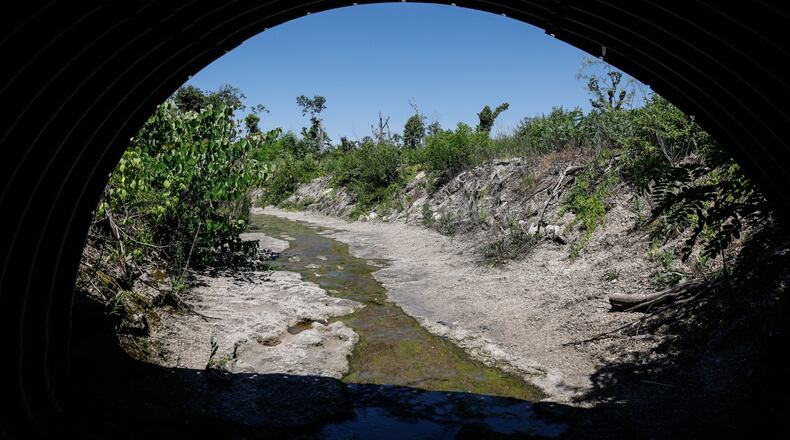Trotwood had little trouble getting owners to sign waivers allowing federal contractors to clear downed trees on creeks along their properties, said Stephanie Kellum, deputy city manager.
“For them, this is the last reminder of what they endured, so they are very eager to get this taken care and behind them,” she said.
Clayton and Trotwood paired up on the project because the same impacted tributaries of Wolf Creek cross East Westbrook Road, the jurisdictional boundary. Any flooding would affect both sides of the border, Clayton City Manager Amanda Zimmerlin said.
“It just builds upstream with more issues, so it really is for the whole community to solve this problem,” Zimmerlin said.
Final engineer’s cost estimates aren’t available, but the USDA grant will cover 75% of the project and the participating jurisdictions will cover 25%.
Fewer than 10 property owners are affected in Clayton, but hundreds are impacted in Trotwood, officials said.
To the west of Hoke Road, cleanup will extend along the North Branch of Wolf Creek, beginning north of East Westbrook Road in Clayton and extending south into Trotwood.
Preliminary plans show an eastern section of the joint project running for 3,530 feet beginning in Clayton on a small creek between Afton Drive, also affecting property owners on Willow Creek Court and Colemere Circle. The creek continues into Trotwood between Hillary Street and Ericsson Way, and continues south between Ericcson Way and Nantucket Road along the Salem Bend Apartments.
If the debris isn’t addressed, potential flooding could affect 300-500 properties, Kellum said, including the Salem Consumer Square Shopping Center and the Home Depot to the south.
Merle Cyphers, Harrison Twp. services director, said large trees crossing a Harrison Twp. creek behind Swallow Drive and south of Sinclair Park haven’t caused a problem — yet.
“They’re just spanning that creek, maybe some small ones hanging down. But as those rot and deteriorate, they’re going to begin to collapse into the creek,” he said. “Then that’s going to cause the flooding at that point, because now you’re getting bigger, large debris that’s creating dams. So we have to get it out of there before that happens.”
The project in Harrison Twp. will clear major storm debris from the drainage that feeds directly into the Stillwater River, a short distance to the east.
“The reason we qualified … is really in regards to river preservation and to stop flooding or potential flooding,” Cyphers said.
Story continues after maps.
Harrison Twp. resident Mike Vaspory once felt secluded living on Finch Street.
“You couldn’t even see this house here,” he said pointing to the other side of the creek. “Not even in the wintertime when all the leaves are gone.”
A mess of debris remains across the road from his house, filling the drainage more than two years after the storm. He said the creek runs higher now when it rains, though it hasn’t caused any serious problems.
“But it’s not good that it’s dammed up from all the trees,” he said.
Seven property owners will have debris cleared from nearly 3,000 feet of Wolf Creek in Brookville before things get worse, City Manager Sonja Keaton said.
“Traveling out of Brookville heading south, a lot of those trees’ root systems are very weak. They’re starting to uproot now with the weather we’ve been experiencing — high winds and torrential rains,” she said. “So we really need to get it taken care of sooner than later.”
The cleanup of Wolf Creek will continue into Perry Twp., where at least one blockage is known, said Mindi Wynne, Perry Twp. trustee president.
According to the Ohio Revised Code, if a drainage system comes onto private property, it becomes the responsibility of the property owner to clean up, but few had the resources, Cyphers said.
“In this type of situation and particularly being a natural disaster, there was no way we could expect all those different property owners to be responsible for cleaning out tornado damage debris from the ditch in their backyards,” he said.
Cyphers predicted each property owner in the Harrison Twp. project area would have been on the hook for $10,000 at minimum.
A huge problem for homeowners was that insurance policies didn’t cover tree removal unless one landed on their residence, Kellum said,
“These are the types of expenses that individual homeowners would have to handle on their own. And it would be contingent upon each individual property owner along this path taking those actions to make this actually effective,” she said. “That is why the jurisdictions saw the importance of collaborating to get this done.”
The jurisdictions were also ill-equipped to handle the job performed by only a handful of contractors with specialized heavy machinery, Cyphers said.
“It’s a big project. It’s something that’s way out of the realm of what we can do in-house,” Cyphers said.
Zimmerlin said the projects were slated for 2020 but delayed by the coronavirus. She expects the work in Clayton should get underway in August.
The tornado projects are a departure for the USDA’s Natural Resources Conservation Service, which most often works with farmers on drainage and manure waste storage facilities, said Vic Vue, a supervisory engineer based in the service’s Englewood office.
“As far as the Dayton area, these are probably the first projects that are of this nature,” he said. “This is not a typical project.”
The four jurisdictions applied for the Natural Resources Conservation Service’s Emergency Watershed Protection grants because the work fell outside the purview of FEMA or the Army Corps of Engineers, Vue said.
The projects are going through the final engineering approval process and Vue expects the service to solicit bids soon for a contractor.
“It’s more involved than going out there with a chainsaw,” he said.
About the Author



